I Was Credited for an Iconic Photo Half a Century Later
![]()
Many a photographer knows from experience that getting a credit line for his or her work may often be the only compensation available. That was my situation when I was employed as a student and photographer at UCLA back — make that WAAAYY back — in 1966-68. My job consisted of photographing just about anything on campus – student government, rallies, “love-ins” and, this being UCLA, football and basketball games.
At those UCLA games, I was at the sideline, or under the basket, while these amazing athletes produced championship banner after championship banner. Those were heady days, indeed.
One of my photos took on a life of its own. I shot it at the Los Angeles Classic tournament in a game between UCLA Bruins and the Minnesota Golden Gophers. Alcindor was a sophomore playing his first season on the varsity. In those days, talented freshmen didn’t go directly into the NBA. There were no “one-and-done’s”. In fact, first year players had their own team, own schedule and very little, if any, fan support.
So in Alcindor’s first varsity season, he proceeded to rewrite all the normal rules of the game, both offensively and defensively. At the Minnesota game, I stationed myself as usual under the Bruin’s basket clicking away at awesome dunks, rebounds and passes. UCLA employed Coach Wooden’s very dynamic full-court press and fast break offense to stun and overwhelm opponents with lightning speed. The first half was dominance as usual.
Seeing how Alcindor was as equally dominant on defense by being able to block just about any shot within reach, I decided to try to photograph that action. To do so, I remained under the Bruin basket, but focused across the court using my telephoto zoom lens. I anticipated that I’d get a blocked shot or two, along with a few rebounds and snappy outlet passes. (To photograph any sport, it is vital to know the flow of the game and the likely actions of the participants.)
Mind you, this all took place in a relatively dimly lit arena compared to the brilliantly lit stages the game is played on today. And I was using something called “film” — Kodak’s mainstay black and white mainstay: Tri-X. Normally it was rated at 400 ASA, but could be “pushed” to 800 or 1600 in the lab for better low-light utility. I honestly don’t recall what ASA I was shooting at, but most likely it was 400.
My Soligor lens certainly wasn’t nearly as fast as those light devouring glass monsters sports photographers carry around now. Nor did I have the luxury of a motor drive that allows a photographer to machine gun a scene with multiple exposures in a single burst. No. I had only my Pentax, my zoom and my knowledge of the game.
That turned out to be just enough to capture perhaps the most iconic and reproduced image of the dynamic action that transpired that evening. As I anticipated, Lew leaped and blocked a Gopher ball. I didn’t fully realize what I captured until the following Monday in the on-campus lab. I looked at the negative and realized that Alcindor had not only blocked the shot, he did so while leaping so high that his waist was eye-level with every other player on the court. Now, at 7’2”, he was already stratospheric in comparison to the competition. The juxtaposition of his body’s elevation and the others, who were all above 6’2”, was Gulliver like.
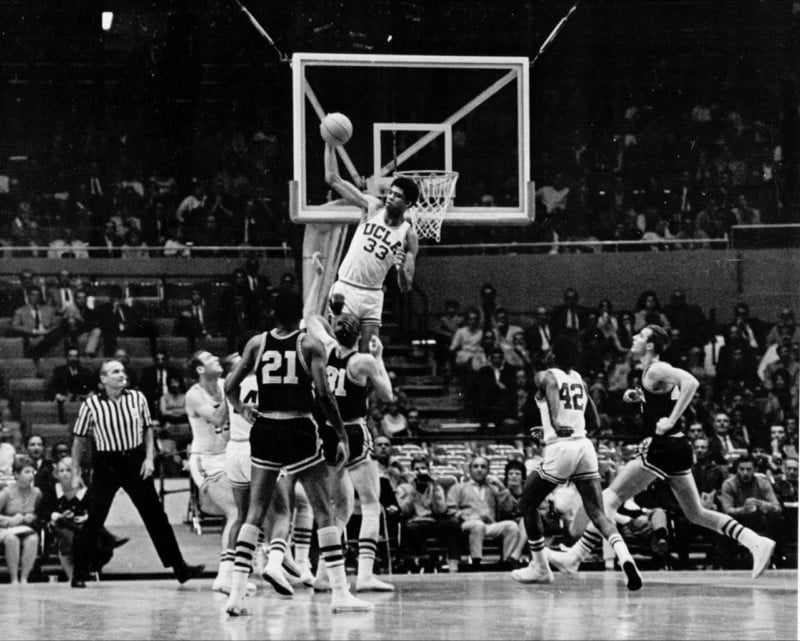
The photo was printed in the school paper, in the school yearbook, sent out by the Athletic Department and who knows where else. I certainly didn’t have the resources to track it. This was decades before Google, mind you. I was just happy I caught the moment. Some years later, I stopped in at Pauley Pavilion, UCLA’s new temple of college basketball. Inside hanging on a wall was my photo probably four or five feet wide in prominent display. I didn’t see any credit line. Hmmmm…
As a student photographer employed by the Associated Students organization, UCLA owned the copyright. Sure a credit would have been nice, to say the least. Maybe someone will remember and put up a small sign? I let it go.
Years and decades passed. I had long since moved from Los Angeles to San Francisco living with a new career, a new home, a new identity. My work in public relations and advertising had put my photography on the sideline. Sure I shot for myself, documented my overseas travels, even hired and art directed pros for my clients. Sometimes, I’d do the required shooting myself, but not so much that I felt I was a pro, too. I was now an “Account Executive”, not a “mere photographer”.
Flash forward to December 2016. I’m in my living room alone (wife, and kids were all out) watching my beloved Bruins playing a Pac-12 conference game on TV. The Pac-12 Network was running a spot about Abdul-Jabbar as being named the “Player of the Century” or something equally monumental. What photo did they use to illustrate his accomplishment? Mine!
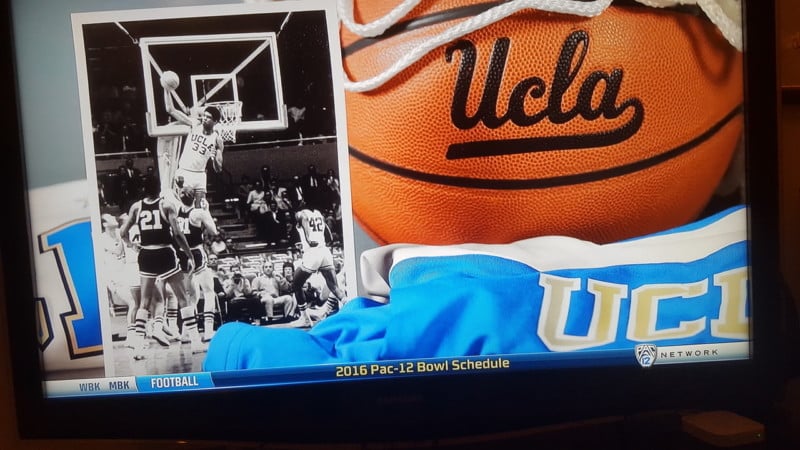
I put the video recorder on pause, rewound it to show the spot again and grabbed my cellphone camera. My first thought was to share this on my Facebook page with a note about how my now half-century old photo was still being used in the media. My own small PR efforts did gain me some recognition among my tribe of Facebook Friends. One of them, thoughtfully, suggested I contact Abdul-Jabbar himself to see about getting a wider following.
Thanks to Google, I located his management company. An email sent with a scanned copy of the photo (I kept a copy of the original 1967 print in my personal collection) was warmly received by his business manager. It turned out to be a very timely email.
Abdul-Jabbar was putting the finishing touches on his own book about Coach John Wooden and welcomed any more photos I might have shot. I had also kept tucked away in a flimsy metal locker box in my garage, several negatives from those days. I did find a few more action shots and surprisingly one taken of Coach Wooden arriving at Los Angeles International Airport upon returning with that year’s national championship team at the NCAA Basketball Tournament. Into the book they’d go. Another book to be published later this year will also feature some of my photos.
As for me, all I asked was to get credit on whatever copies of my famous photo were now hanging at Pauley, and for Kareem to sign a print for my own personal gratification. Both requests were gratefully accepted.
It turned out that the UCLA Athletic Department was planning a 50-year reunion of that 1966-67 championship team and would be honored at halftime of the upcoming UCLA – Washington State game. The old PR man in me saw a Photo Op not to be missed. If Kareem was going to be there, would he pose with me by my photo of him before the game? Yes, he would. So I bought an airline ticket from Oakland to LAX, went to the dinner with that 30-0 team, sat with my former classmates and basketball heroes, and walked through Pauley Pavilion with a very tall, very gracious and quite humble man who had leaped into UCLA photographic history one balmy LA December night in front of my lens.
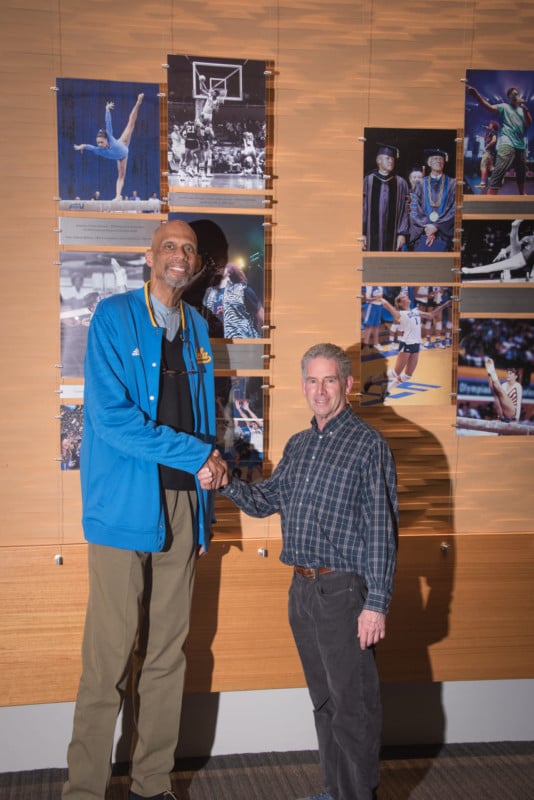
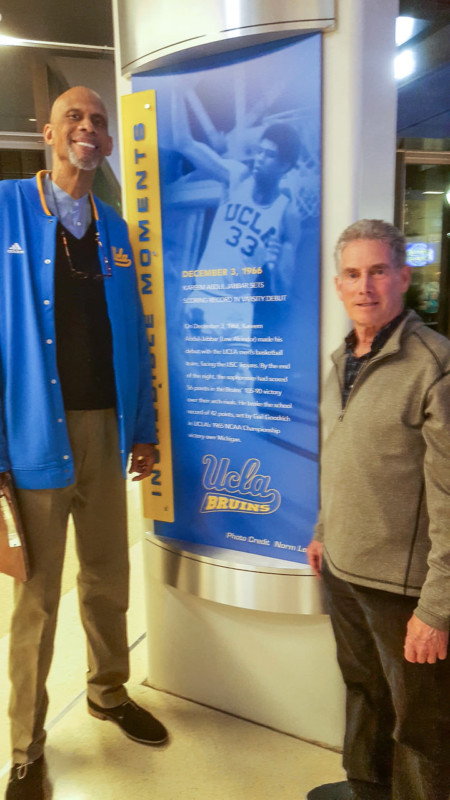
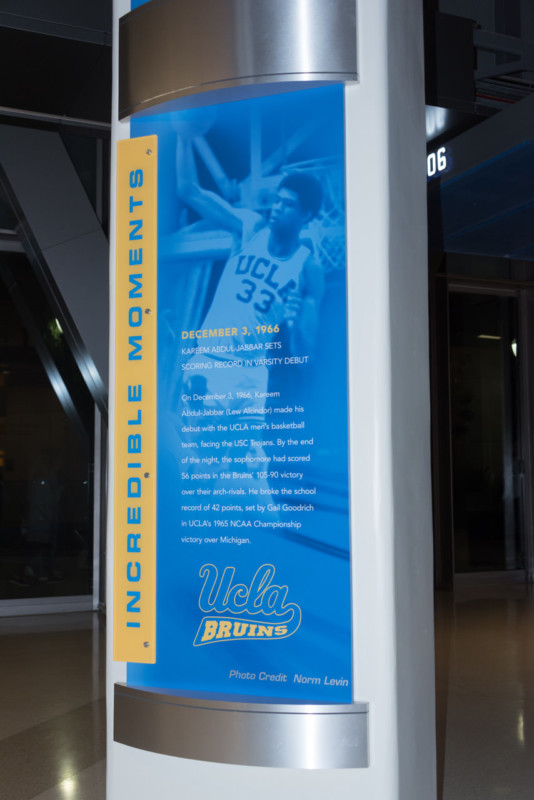

I pitched this story to my local newspaper, the Marin Independent Journal, who interviewed me as well as published the photo in their article. I’m sharing my story here because no matter how old you get or how long ago you took a photograph that made an impression on people, it’s always nice to get credit. (Also to provide a more photographic background on how it all came to be.)
After the Great Recession of 2008, I had to change careers again, as nobody was hiring PR agencies anymore. So I returned to my first love – photography. The result has been a successful Marin County event and portrait business called Natural Portraits and Events. And yes, I also still shoot sports.
As I told the Marin IJ sports editor, photographing a wedding or bar mitzvah party requires many of the same photographic skills as shooting a football or basketball game. You have know what the “players” are likely going to do next, get in the right position, anticipate their moves, and have quick reflexes.
With today’s technologically advanced cameras and editing software, there’s a considerably greater margin of error and capability to correct those errors. Having to work under the technological constrictions of film during my seminal learning years, I believe, has given me an advantage over those photographers who only experienced the digital age. However, one advantage young and media savvy photographers have these days is that they learn pretty quickly to get credit.
I do not recommend waiting 50 years… if it can be helped.
Image credits: Photos by Norm Levin, with Stan Berkowitz